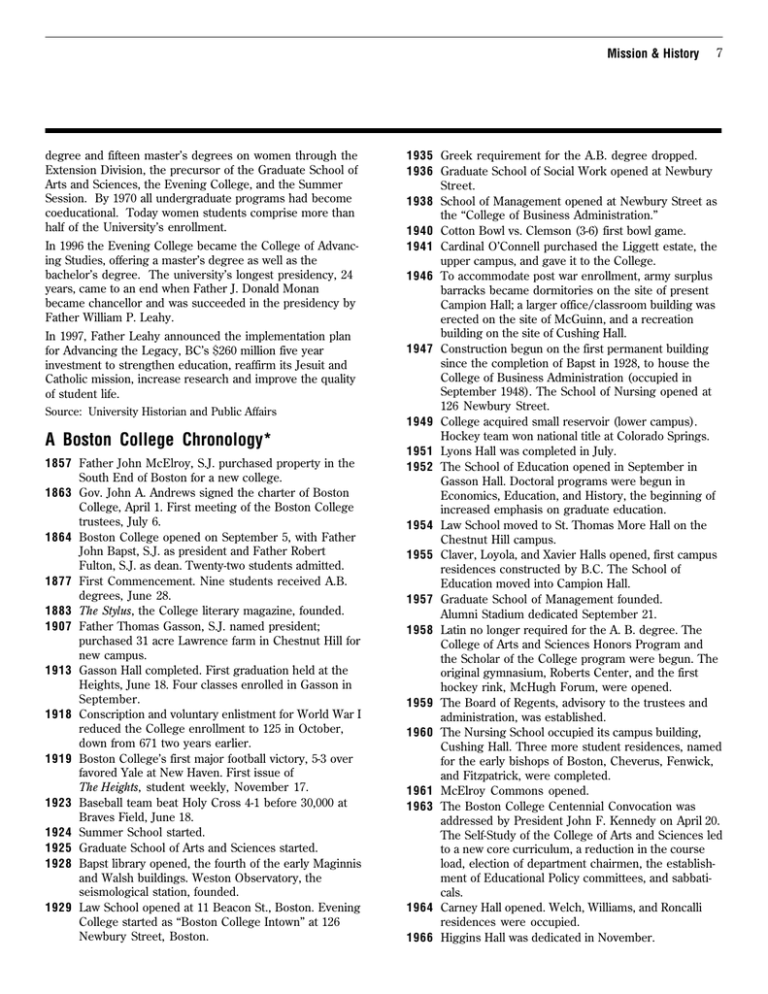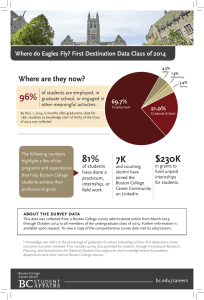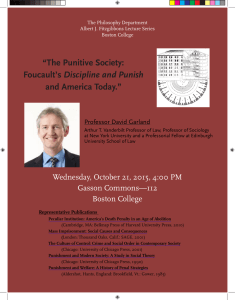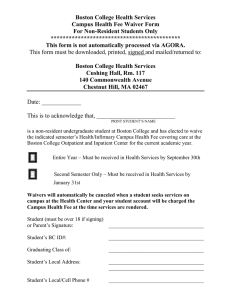7 Mission & History
advertisement

Mission & History degree and fifteen master’s degrees on women through the Extension Division, the precursor of the Graduate School of Arts and Sciences, the Evening College, and the Summer Session. By 1970 all undergraduate programs had become coeducational. Today women students comprise more than half of the University’s enrollment. In 1996 the Evening College became the College of Advancing Studies, offering a master’s degree as well as the bachelor’s degree. The university’s longest presidency, 24 years, came to an end when Father J. Donald Monan became chancellor and was succeeded in the presidency by Father William P. Leahy. In 1997, Father Leahy announced the implementation plan for Advancing the Legacy, BC’s $260 million five year investment to strengthen education, reaffirm its Jesuit and Catholic mission, increase research and improve the quality of student life. Source: University Historian and Public Affairs A Boston College Chronology* 1857 Father John McElroy, S.J. purchased property in the South End of Boston for a new college. 1863 Gov. John A. Andrews signed the charter of Boston College, April 1. First meeting of the Boston College trustees, July 6. 1864 Boston College opened on September 5, with Father John Bapst, S.J. as president and Father Robert Fulton, S.J. as dean. Twenty-two students admitted. 1877 First Commencement. Nine students received A.B. degrees, June 28. 1883 The Stylus, the College literary magazine, founded. 1907 Father Thomas Gasson, S.J. named president; purchased 31 acre Lawrence farm in Chestnut Hill for new campus. 1913 Gasson Hall completed. First graduation held at the Heights, June 18. Four classes enrolled in Gasson in September. 1918 Conscription and voluntary enlistment for World War I reduced the College enrollment to 125 in October, down from 671 two years earlier. 1919 Boston College’s first major football victory, 5-3 over favored Yale at New Haven. First issue of The Heights, student weekly, November 17. 1923 Baseball team beat Holy Cross 4-1 before 30,000 at Braves Field, June 18. 1924 Summer School started. 1925 Graduate School of Arts and Sciences started. 1928 Bapst library opened, the fourth of the early Maginnis and Walsh buildings. Weston Observatory, the seismological station, founded. 1929 Law School opened at 11 Beacon St., Boston. Evening College started as “Boston College Intown” at 126 Newbury Street, Boston. 7 1935 Greek requirement for the A.B. degree dropped. 1936 Graduate School of Social Work opened at Newbury Street. 1938 School of Management opened at Newbury Street as the “College of Business Administration.” 1940 Cotton Bowl vs. Clemson (3-6) first bowl game. 1941 Cardinal O’Connell purchased the Liggett estate, the upper campus, and gave it to the College. 1946 To accommodate post war enrollment, army surplus barracks became dormitories on the site of present Campion Hall; a larger office/classroom building was erected on the site of McGuinn, and a recreation building on the site of Cushing Hall. 1947 Construction begun on the first permanent building since the completion of Bapst in 1928, to house the College of Business Administration (occupied in September 1948). The School of Nursing opened at 126 Newbury Street. 1949 College acquired small reservoir (lower campus). Hockey team won national title at Colorado Springs. 1951 Lyons Hall was completed in July. 1952 The School of Education opened in September in Gasson Hall. Doctoral programs were begun in Economics, Education, and History, the beginning of increased emphasis on graduate education. 1954 Law School moved to St. Thomas More Hall on the Chestnut Hill campus. 1955 Claver, Loyola, and Xavier Halls opened, first campus residences constructed by B.C. The School of Education moved into Campion Hall. 1957 Graduate School of Management founded. Alumni Stadium dedicated September 21. 1958 Latin no longer required for the A. B. degree. The College of Arts and Sciences Honors Program and the Scholar of the College program were begun. The original gymnasium, Roberts Center, and the first hockey rink, McHugh Forum, were opened. 1959 The Board of Regents, advisory to the trustees and administration, was established. 1960 The Nursing School occupied its campus building, Cushing Hall. Three more student residences, named for the early bishops of Boston, Cheverus, Fenwick, and Fitzpatrick, were completed. 1961 McElroy Commons opened. 1963 The Boston College Centennial Convocation was addressed by President John F. Kennedy on April 20. The Self-Study of the College of Arts and Sciences led to a new core curriculum, a reduction in the course load, election of department chairmen, the establishment of Educational Policy committees, and sabbaticals. 1964 Carney Hall opened. Welch, Williams, and Roncalli residences were occupied. 1966 Higgins Hall was dedicated in November. 8 Chronology 1968 The Regents joined the Jesuit trustees to form the Board of Directors, October 8. The Black Talent Program was started, precursor to AHANA Student Programs. 1970 Women admitted for degrees in all undergraduate colleges (Sept.). The modular residences were placed on the lower campus. Pulse, an academic/social action program, was started. The Campus School for multi-handicapped children was begun. 1971 The office of president of Boston College and rector of the Boston College Jesuit community were separated on January 1. Installation of Omicron Chapter, Phi Beta Kappa, April 6. 1972 Father J. Donald Monan succeeded Father Joyce as president, September 5. The trustees voted to eliminate the Board of Directors and to expand the Board of Trustees to include laymen, November 19. The newly structured Board of Trustees, with 35 members (13 Jesuits), elected Cornelius Owens ’36 chairman. The Women’s Center was established. 1973 The Long-Range Fiscal Planning Committee presented to the Trustees a plan for balanced budgets for the succeeding five years. 1974 Newton College of the Sacred Heart became part of Boston College (announced March 11). 1975 The Law School moved to the Newton Campus. Edmond’s Hall was occupied in September. 1976 The New Heights Advancement Campaign to raise $21 million over five years was begun in April. By 1981 it raised more than $25 million. 1979 1,000 friends of Speaker Thomas P. O’Neill gathered in Washington for a dinner attended by President Carter to establish the O’Neill Chair in American Politics, December 9. The Graduate School of Social Work established a doctoral degree program. The Recreation Complex named for Athletic Director, William J. Flynn. 1980 The Jesuit community endowed the Thomas I. Gasson, S.J. Chair for distinguished Jesuit scholars. 1982 Walsh Hall residence dedicated to former president Michael P. Walsh, S.J., October 7. 1984 O’Neill Library dedicated to Speaker of the House Thomas P. O’Neill, ’36, October 14. Doug Flutie awarded Heisman Trophy. 1985 The E. Paul Robsham, Jr. Theater Arts Center was dedicated on October 25. 1986 Rededication of renovated Bapst Library, dedication of Burns Library, April 22. Goals for Nineties (planning document) published. Alumni Association moved to Alumni House on the Newton Campus. St. Patrick’s Day dinner in Washington honoring Speaker Thomas P. O’Neill. Speakers included President Reagan, former President Gerald Ford, and Bob Hope. $2 million was raised for B.C. scholarships. Five year $125 million Campaign for Boston College started. 1987 1988 1989 1991 1992 1993 1994 1995 The dismantling of McHugh Forum was begun to make way for Conte Forum. The Carroll Graduate School of Management’s doctoral program in finance was approved by the Trustees. The Jesuit Institute, funded by a $1.5 million gift from the Jesuit community, with a matching University subsidy, was founded to promote research on the religious and Jesuit traditions of Boston College. The first students enrolled in the new Nursing Ph.D. program. The Music Program became a department of the College of Arts and Sciences. Vouté Hall and its companion student residence were occupied. The Museum of Art (then called the art gallery) was opened in Devlin Hall. Father Peter-Hans Kolvenbach, Superior General of the Society of Jesus, spoke at celebrations of the University’s 125th anniversary, October 5 and 7. Congressman Silvio O. Conte ’49 was present for the dedication of Conte Forum on February 18. The School of Management became the Carroll School of Management and the Carroll Graduate School of Management in honor of Wallace E. Carroll ’28. Sister Thea Bowman was awarded an honorary degree and AHANA House was named for her in October. Roberts Center was razed to make room for the Merkert Chemistry Center. Wing added to Campion Hall, with major renovation of the original building. The Eugene F. Merkert Chemistry Center dedicated. The Campaign for Boston College completed, exceeding the $125 million goal by over $11 million. Renovated Devlin Hall welcomed as occupants the Department of Geology and Geophysics, the Department of Fine Arts, the Art Museum, and the Admission Office. The football team beat Notre Dame at South Bend, 41–39, when Notre Dame was ranked No. 1 in the country. Renovation of Fulton Hall was begun. A new core curriculum went into effect in September. The Department of Theater was established. Two new residences, 70 and 90 St. Thomas More Road, were completed and occupied. The graduate programs in Nursing and Education separated from the Graduate School of Arts & Sciences. Father Monan established a new University Academic Planning Council to map university strategies for the near future. A new dining facility was opened alongside Robsham Theater, and a garage for 900 cars was completed behind St. Mary’s Hall. The stadium seating capacity was enlarged from 32,000 to 44,500. For the second year in a row the football team defeated Notre Dame. On October 6, 1995, the trustees elected Father William P. Leahy to succeed Father J. Donald Monan as president. Fulton Hall reopened, enlarged and Chronology transformed exteriorly to match the Gothic style of the early buildings. The university’s endowment placed it among the thirty-five largest in the U.S. The Brighton-Allston Boston College Neighborhood Center was established. 1996 The Law School’s new library was completed and opened on the Newton campus in January. U.S. News and World Report ranked Boston College 16th among the nation’s teaching universities and 37th in the national universities category. The student residence at 70 St. Thomas More Road was named Thomas A. and Margaret A. Vanderslice Hall; the nearby residence building at number 80 was named Gabelli Hall; and the Art Museum became the Charles S. and Isabella V. McMullen Museum of Art. On May 1 the university community honored retiring president Monan with a warm, joyous celebration. The University Academic Planning Council’s final report, “Advancing the Legacy: The New Millennium,” was published in May. On July 31 Father Monan’s 24-year presidency ended and Father William Leahy donned the mantle of president. Father William P. Leahy was inaugurated as the 25th president of Boston College on October 18. At the formal inauguration ceremony, good wishes were brought by Bernard Cardinal Law, Governor William F. Weld, Jesuit Provincial Rev. William A. Barry, MIT President Charles Vest, and by representatives of the Boston College alumni, faculty, students, and staff. In January, the School of Nursing celebrated its golden jubilee anniversary. 1997 In a rating of graduate schools, US News and World Report placed Boston College Law School 22nd in its field while the Graduate School of Social Work was ranked 14th, the School of Nursing 27th, and the School of Education 28th. In March, Father Leahy was homilist at the annual St. Patrick’s Day Mass at the Cathedral of the Holy Cross in Boston. 1998 Irish politics was in the spotlight at Boston College in 1998. In October, Irish President Mary McAleese visited the campus for the formal opening of the Irish Institute and the Irish Studies Program in Connolly House. Irish Prime Minister Bertie Ahern was the commencement speaker in May. Rev. William Neenan, SJ, was named vice president and special assistant to University President Rev. William Leahy, SJ. Rev. Joseph Appleyard, SJ, was named vice president for University Mission and Ministry. Rev. J. Robert Barth, SJ, announced he would step down as dean of the College of Arts and Sciences. Rev. Francis Sweeny, SJ, retired as director of the Lowell Lecture Humanities Series. Work began on a three-year project to renovate and expand Higgins Hall, which houses the Biology and Physics departments. U.S. News & World Report rated the BC schools of law, education, and nursing among the top 25 in their 9 fields. BC undergraduates won more than 20 prestigious national fellowships, including a dozen Fulbrights and a coveted Marshall Scholarship. BC mourned the passing of University Historian, Rev. Charles Donovan, SJ, who was founding dean of the School of Education and author of the History of Boston College. 1999 University President, Rev. William Leahy, SJ, named Dr. Jack Neuhauser, dean of the Carroll School of Management, as academic vice president. Joseph F. Quinn, Professor of Economics, was chosen to succeed Rev. J. Robert Barth, SJ, as dean of the College of Arts and Sciences. Professor Thomas H. O’Connor was appointed University Historian. Jack Dunn was named BC’s new director of Public Affairs. BC’s School of Education was named the Peter S. and Carolyn A. Lynch School of Education in recognition of the couple’s gift of more than $10 million. For the fifth consecutive year, BC was ranked among the top 40 national universities by U.S. News & World Report. The biggest leap in BC’s standing was “faculty resources,” where BC moved up to 54th place from 87th place two years ago. BC also ranked fifth in the nation in graduating football players. The McMullen Museum of Art’s exhibition, Saints and Sinners: Caravaggio and the Baroque Image, attracted more than 65,000 visitors to the campus. The University purchased property on the east side of Dublin’s St. Stephen’s Green for the BC Center in Ireland. BC announced a $400 million “Ever to Excel” capital campaign, with an anonymous donor pledging $20 million. * References to presidents and Board of Trustee chairmen are minimized in this chronology since they are listed elsewhere in this Fact Book. Source: University Historian and Public Affairs




